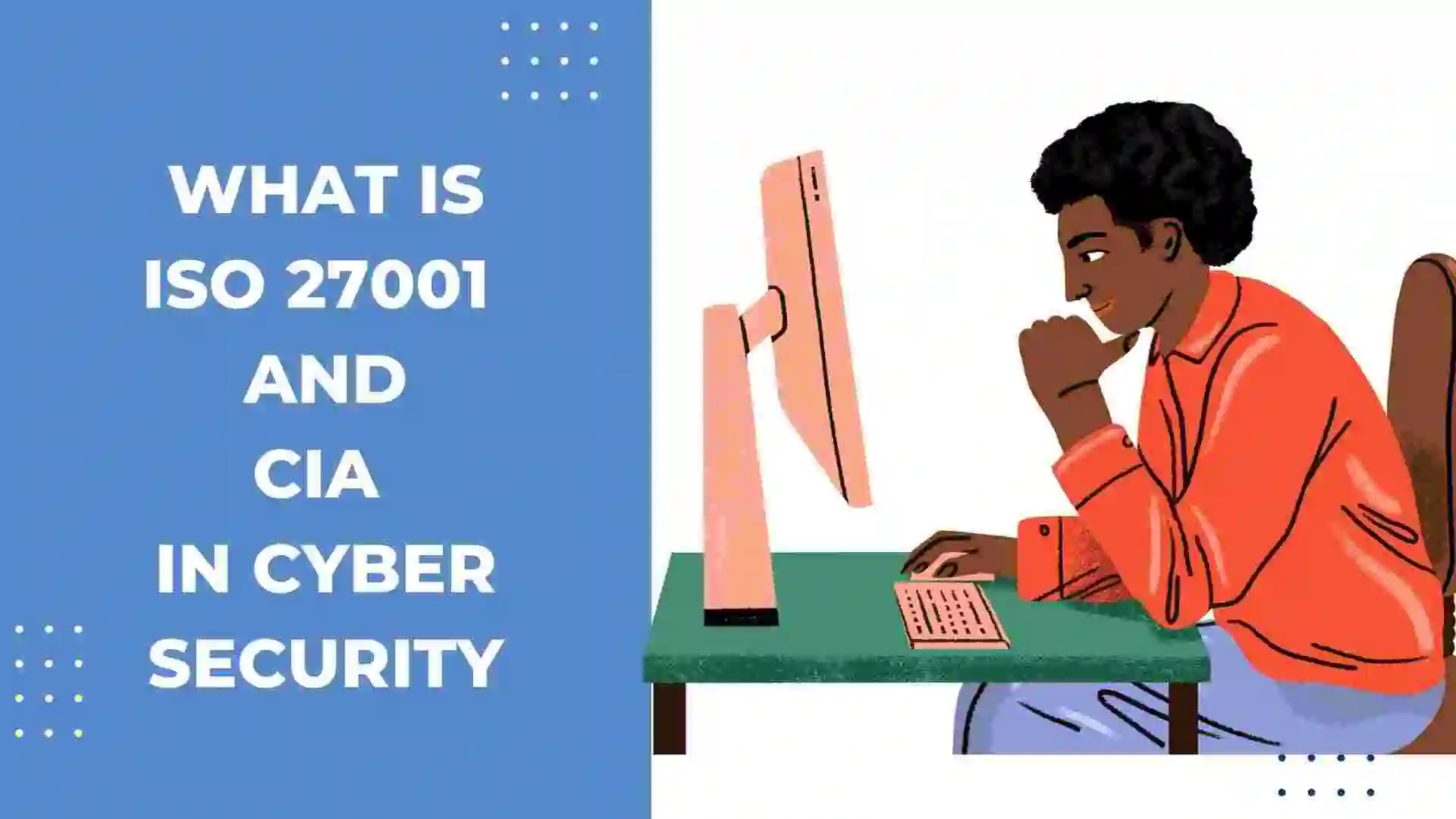In this blog, we will learn about ISO 27001 and the CIA, which are two of the most important Cyber Security Laws. We will see the main purpose of this law and its reasons. So let’s get started with the blog.
Table of Contents
- Introduction to ISO 27001
- Key aspects of ISO 27001
- Implementation of ISO 27001
- The purpose of ISO 27001
- CIA in Cyber Security
- Benefits of ISO 27001
- FAQ
- Recent Articles on Computer Networks
- Blogs Related to Cyber Security
Introduction to ISO 27001
ISO 27001, formally known as ISO/IEC 27001, is an internationally recognized standard that provides a systematic framework for establishing, implementing, operating, monitoring, reviewing, maintaining, and improving an Information Security Management System (ISMS) within the context of an organization’s business risks.
The standard outlines the requirements and best practices for effectively managing information security to protect the confidentiality, integrity, and availability of sensitive information and data assets.
Key aspects of ISO 27001
Here are the key aspects of ISO 27001:
A) Scope and Objectives:
ISO 27001 defines the scope of the ISMS, specifying the boundaries and limitations of the system. Organizations determine what information assets are covered and the extent of the security controls to be applied. The primary objective is to ensure the secure handling of information, prevent data breaches, and manage information-related risks effectively.
B) Risk Management:
A significant focus of ISO 27001 is on risk management. Organizations must identify potential threats, vulnerabilities, and risks to their information assets. After identifying these risks, they evaluate their potential impact and likelihood and then implement appropriate security controls to mitigate or manage them to an acceptable level. This risk-based approach ensures that security efforts are tailored to the organization’s specific needs and challenges.
C) Security Controls:
The standard provides a comprehensive set of security controls that organizations can choose from to address the identified risks. These controls cover various aspects of information security, including access control, cryptography, physical security, human resources security, and more. Organizations must select and implement the controls that are most relevant to their operations and risk profile.
D) Documentation and Processes:
ISO 27001 requires organizations to develop and maintain documentation related to their ISMS. This includes policies, procedures, guidelines, and records that detail how information security is managed throughout the organization. Well-documented processes ensure consistency and clarity in security practices across different departments and functions.
E) Continuous Improvement:
ISO 27001 follows the Plan-Do-Check-Act (PDCA) cycle, emphasizing continuous improvement. Organizations plan their security measures, implement them, regularly assess their effectiveness through internal audits and reviews, and then take corrective actions as needed to enhance the ISMS. This iterative process ensures that the ISMS evolves to address new threats and challenges.
F) Certification and Compliance:
Organizations can undergo a formal certification process to demonstrate their compliance with ISO 27001. Independent certification bodies assess an organization’s ISMS to ensure it meets the standard’s requirements. Achieving ISO 27001 certification signals to stakeholders that the organization has established robust information security practices.
Implementation of ISO 27001
Steps for ISO 27001 Implementation Process:
- Initiation: Define the scope and objectives of the ISMS implementation.
- Risk Assessment: Identify and assess information security risks to determine necessary controls.
- Risk Treatment: Implement controls to mitigate identified risks to an acceptable level.
- Documentation: Create the necessary policies, procedures, and documentation for the ISMS.
- Training and Awareness: Educate employees about information security roles and responsibilities.
- Monitoring and Review: Continuously monitor and assess the effectiveness of the ISMS.
- Internal Audits: Regularly conduct internal audits to ensure compliance with ISO 27001 requirements.
- Management Review: Periodically review the ISMS’s performance with top management.
- Continuous Improvement: Use audit findings and reviews to make necessary improvements to the ISMS.
Implementing ISO 27001 is a comprehensive process that requires commitment from top management and collaboration across different departments within an organization.
The purpose of ISO 27001
The purpose of ISO 27001, which is formally known as ISO/IEC 27001, is to provide organizations with a structured framework for establishing, implementing, operating, monitoring, reviewing, maintaining, and continually improving an Information Security Management System (ISMS). The standard aims to help organizations effectively manage the security of their information assets, protect sensitive data, and mitigate risks related to information security.
Here are the primary purposes of ISO 27001:
A) Information Security Management System (ISMS) Establishment:
ISO 27001 provides a systematic approach for organizations to create a structured ISMS. This system involves defining policies, processes, procedures, and controls to manage information security across the organization.
B) Risk Management:
The standard emphasizes a risk-based approach to information security. ISO 27001 guides organizations in identifying potential threats and vulnerabilities to their information assets, evaluating their impact and likelihood and then implementing appropriate controls to manage or mitigate these risks.
C) Confidentiality, Integrity, and Availability:
ISO 27001 focuses on maintaining the confidentiality, integrity, and availability of information assets. Organizations must safeguard sensitive information, prevent unauthorized access or disclosure, ensure data accuracy, and make information available when needed.
D) Legal and Regulatory Compliance:
ISO 27001 helps organizations ensure that their information security practices align with relevant laws, regulations, and contractual obligations. This is particularly important in industries with strict compliance requirements, such as healthcare and finance.
E) Continuous Improvement:
ISO 27001 follows the Plan-Do-Check-Act (PDCA) cycle, promoting a culture of continuous improvement. Organizations regularly review their information security practices, assess their effectiveness, and take corrective actions to enhance their ISMS.
F) Stakeholder Confidence:
Implementing ISO 27001 demonstrates an organization’s commitment to information security and can enhance trust among customers, partners, and stakeholders. ISO 27001 certification from a recognized certification body adds credibility to an organization’s security practices.
G) Holistic Approach:
ISO 27001 encourages a holistic approach to information security. Instead of ad hoc security measures, organizations establish a comprehensive and coordinated strategy to manage all aspects of information security.
In summary, ISO 27001 serves as a comprehensive framework that enables organizations to systematically address information security challenges, manage risks, and establish a robust foundation for protecting sensitive information. Its implementation can lead to improved security practices, increased stakeholder confidence, and enhanced overall business resilience.
CIA in Cyber Security
“CIA” refers to the fundamental principles of information security: Confidentiality, Integrity, and Availability. These principles form the cornerstone of designing and implementing effective security measures to protect information and digital assets. Let’s delve into each of these principles:
1) Confidentiality:
Confidentiality focuses on ensuring that information is accessible only to those who have the proper authorization. It involves preventing unauthorized access, disclosure, or leakage of sensitive and confidential information. Measures such as encryption, access controls, authentication, and secure communication protocols are employed to maintain confidentiality. Confidentiality is crucial to protecting sensitive data from being accessed by unauthorized individuals or entities.
2) Integrity:
Integrity pertains to the accuracy, reliability, and trustworthiness of information and data. Ensuring data integrity involves preventing the unauthorized modification, alteration, or deletion of information by unauthorized parties. Techniques like data validation, checksums, digital signatures, and version controls are used to maintain the integrity of information. Maintaining data integrity ensures that information remains accurate and trustworthy throughout its lifecycle.
3) Availability:
Availability involves making sure that information and resources are available and accessible when needed by authorized users. This principle aims to prevent disruptions, downtime, and denial of service attacks that could impact an organization’s ability to function. Measures such as redundancy, backup and recovery strategies, load balancing, and fault tolerance are implemented to ensure the continuous availability of critical systems and data.
These three principles—Confidentiality, Integrity, and Availability—often referred to as the CIA triad, work together to create a balanced and comprehensive approach to cybersecurity. It’s important to note that these principles are interconnected, and decisions made to enhance one principle can sometimes impact the others. For example, increasing availability might involve using redundant systems, but this could potentially impact confidentiality if not properly managed.
The CIA triad provides a foundation for designing security controls, policies, and procedures within an organization’s Information Security Management System (ISMS), as outlined in standards like ISO 27001. A robust cybersecurity strategy takes into account all three principles to ensure that information is protected from a wide range of threats and risks, including unauthorized access, data breaches, cyberattacks, and more.
Additionally, some variations of the CIA triad include additional principles such as Authenticity, Non-Repudiation, and Accountability, which further enhance the comprehensive nature of information security principles.
Benefits of ISO 27001
Implementing ISO 27001, the international standard for Information Security Management Systems (ISMS), offers a range of benefits to organizations across different industries. Here are some key advantages:
A) Improved Information Security:
ISO 27001 provides a structured framework for identifying and managing information security risks. By implementing its controls and practices, organizations can enhance the security of their information assets, reducing the likelihood of data breaches and cyberattacks.
B) Risk Management:
The standard’s risk-based approach helps organizations identify and assess potential security risks. This enables informed decision-making about which risks to mitigate, avoid, or accept based on their potential impact and likelihood.
C) Competitive Advantage:
ISO 27001 certification can give organizations a competitive edge. It can serve as a differentiator when bidding for contracts or partnerships, especially when dealing with security-conscious clients.
D) Better Supplier Relationships:
Many organizations require their suppliers and partners to adhere to certain security standards. ISO 27001 certification can facilitate smoother collaboration by demonstrating compliance with these standards.
E) Reduced Incidents and Breach Costs:
Implementing ISO 27001’s security controls can minimize the occurrence of security incidents and data breaches. This can lead to cost savings associated with incident response, recovery, and potential legal actions.
F) Global Recognition:
ISO 27001 is internationally recognized and respected. Certification from accredited bodies demonstrates that an organization meets stringent security standards.
In summary, ISO 27001 offers a structured and comprehensive approach to information security management. Its implementation not only strengthens an organization’s security posture but also brings tangible business benefits, ranging from improved customer trust to cost savings through reduced incidents and enhanced operational efficiency.
Note: This blog is mostly based on TechTarget.
FAQ
ISO 27001, formally known as ISO/IEC 27001, is an internationally recognized standard that provides a systematic framework for establishing, implementing, operating, monitoring, reviewing, maintaining, and improving an Information Security Management System (ISMS) within the context of an organization’s business risks.
“CIA” refers to the fundamental principles of information security: Confidentiality, Integrity, and Availability.
Recent Articles on Computer Networks
- Introduction to Computer Networking | What is Computer Network
- What are Topology & Types of Topology in Computer Network
- What is FootPrinting in Cyber Security and its Types, Purpose
- Introduction to Cloud Computing | What is Cloud Computing
- Distributed Shared Memory and its advantages and Disadvantages
- What is VPN? How doe VPN Work? What VPN should I use?
- What is an Internet and How the Internet Works
- What is a Website and How Does a Website or web work?
- Introduction to Virus and different types of Viruses in Computer
- What is TCP and its Types and What is TCP three-way Handshake
- What is UDP Protocol? How does it work and what are its advantages?
- What is an IP and its Functions, What is IPv4 and IPv6 Address
- What is MAC Address and its Types and Difference MAC vs IP
- What is ARP and its Types? How Does it Work and ARP Format
- Sessions and Cookies and the Difference Between Them
- What is ICMP Protocol and its Message Format?
- What is Big Data? Characteristics and Types of Big Data
- Disciplines of CyberSecurity | What are the goals of CyberSecurity?
- What is Firewall, Features, Types and How does the Firewall Work?
- Network Scanning, Types, and Stealth Scan in Computer Network
- Cryptography and its Types in Ethical Hacking
- Tor Browser and How does it Work | Onion Router Tutorial
- Proxy Server, Advantages, Difference between Proxy Server & VPN
- DHCP Protocol and What Are the Pros and Cons of DHCP
- Intrusion Detection System(IDS) and What are the types of IDS
- Domain Name Server, How Does It Work, and its advantages
- Telnet: Introduction, How Does it Work, and Its Pros and Cons
- SOC: Introduction, Functions performed by SOC, and its Pros
- What is SIEM? | What is the Difference between SIEM and SOC?
- Application Layer in OSI Model | OSI Model Application Layer
- What is SSL Protocol or SSL/TLS and SSL Handshake, and Architecture of SSL
Blogs Related to Cyber Security
- What is Ethical Hacking || Introduction to Ethical Hacking
- System Security and Protection in Cybersecurity
- HIPAA (Health Insurance Portability and Accountability Act) in Cyber Security Law
- PCI DSS (Physical Card Industry and Data Security Standard) in Cyber Security Law
- What is GLBA (Gramm-Leach-Bliley Act) in Cyber Security Law?
- What is NIST (National Institute of Standards and Technology)?
- What is GDPR (General Data Protection Regulation)?



